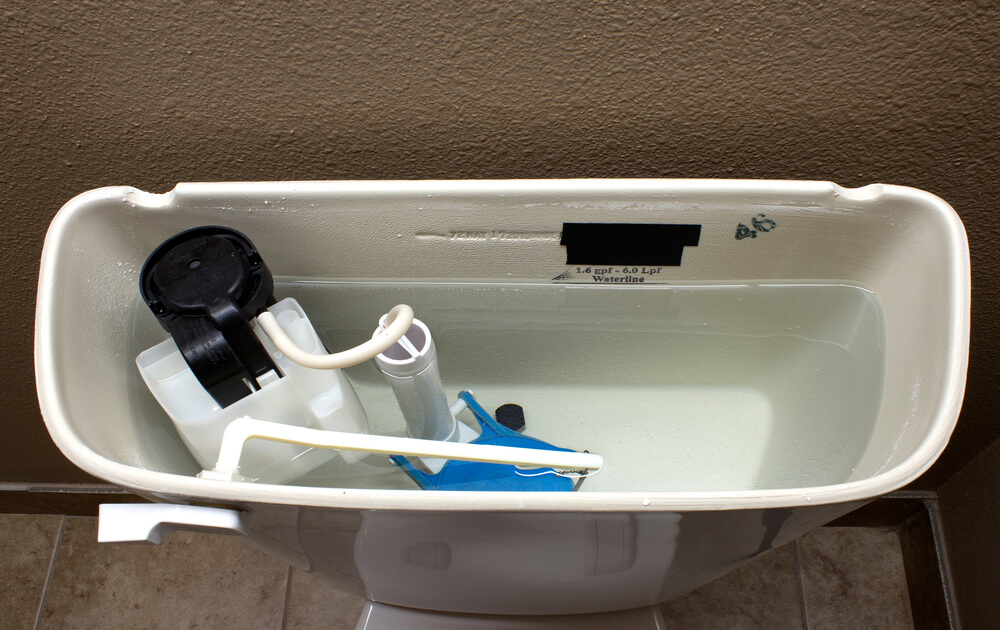The most commonly forgotten piece of furniture to clean is the toilet tank. Most, if not every, toilet uses a tank as a water reservoir to the toilet flush. The frequency of cleaning your toilet tank depends on the water quality. Hard water and well water are causes for more residue and mineral deposits to be left behind on your toilet tank. When your toilet tank is clean, it makes it easier to keep the toilet bowl clean. Fortunately, the toilet tank cleaning process is pretty simple and can be done with things you most likely already have.
Toilet Tank Cleaning Schedule
At the very least, you should be cleaning your toilet tank twice per year. If you have well water or hard water, you should be cleaning your toilet tank four times a year or every other month, depending on how fast the mineral deposits and residue build up. By cleaning the tank routinely, you will prevent rust stains and mineral deposits of the toilet bowl. Additionally, the mechanical components inside will be working properly thanks to regularly checking up on the toilet tank’s water quality.
What to Clean the Toilet Tank With
It is pretty simple, you really only need five things: You will need a long-handled scrub brush, a sponge, rubber gloves, distilled white vinegar, and a disinfectant cleaner.
Cleaning Your Toilet Tank
Before you can start cleaning, you need to shut off the water flowing into the toilet tank. Locate the water valve and switch it off. The water valve is almost always behind the toilet, going into the wall or floor. Turn the valve clockwise until the water is shut off. Next, you will need the tank completely empty before you can clean it. With the water valve shut, you have to flush the toilet until there is no longer any water in the tank; this may require multiple flushes depending on how large your toilet tank is. Analyze your toilet tank; do you see any discoloration around the top or bottom of the tank? If the answer is yes, use distilled white vinegar to clean these areas of discoloration. A common malpractice is to use bleach to remove these stains, however bleach will damage the seals inside your toilet. A disinfectant cleaner can be used on the sides and bottom of the toilet tank, but spray carefully to avoid any mechanical parts that will erode from the disinfectant. The cleaner will need time to eat at the grime, so allow ten minutes of “sitting” before you attempt to scrub away the stains. The sponge can be used with a little dab of disinfectant cleaner to wipe down the moving parts inside the toilet tank, such as the flaps and valves. Be sure to turn the water valve open (counterclockwise) to allow the reservoir to fill, flush your toilet a few times, and your toilet tank is clean.
Deep Cleaning Your Toilet Tank
Should you find your toilet tank to be in need of a deep clean, use distilled white vinegar instead of disinfectant cleaner. The acid content in the vinegar will gradually break down the mineral deposits without harming the moving parts inside the toilet tank. This will require you to empty the toilet tank and fill it full of vinegar, which may need a few gallons. Likewise, you will need to shut the water valve off so the tank will not refill after flushing it empty. When the tank has been emptied of water and filled with vinegar, let it sit idle for a minimum of 12 hours. After half a day of patience, simply flush out the vinegar and clean the tank with your long-handled scrub brush. Same as before, use a sponge to clean the mechanical parts of the toilet like the flapper. Turn the water valve back on to let the reservoir fill up again, flush a few times to clear out any debris, and your toilet tank is deep cleaned.








